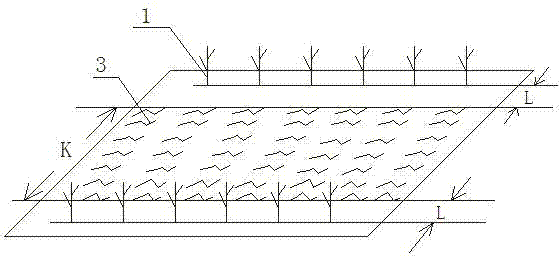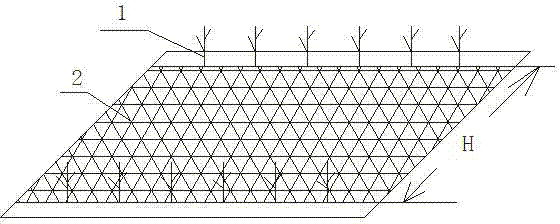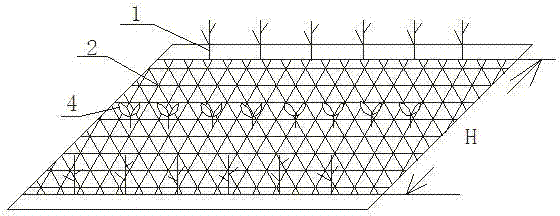Protective cultivation method of tea garden
A cultivation method and protective technology, applied in the field of protective cultivation in tea gardens, can solve problems such as increased use of chemical fertilizers and pesticides, water and soil erosion in tea gardens, and weak growth of tea trees, so as to reduce water and soil erosion, increase tea yield, and improve soil content. The effect of increasing the amount of water
- Summary
- Abstract
- Description
- Claims
- Application Information
AI Technical Summary
Problems solved by technology
Method used
Image
Examples
Embodiment 1
[0055] Example 1 Crop stalk dead cover mode
[0056] Varieties of tea trees for testing: Zijuan,. The tea garden experiment was set up as two treatments: the protective cultivation method of crop straw mulching and the customary cultivation (control), and the area of each experimental plot was 60 square meters.
[0057] Control treatment: no covering planting, keep clear tillage, completely bare soil, weed removal 5-6 times a year, intertillage 1 time, topdressing urea 150kg / ha in July, and farmyard manure or compound fertilizer as base fertilizer in December. Fertilizer dosage 15000kg / ha or compound fertilizer (N-P 2 0 5 -K 2 0 is 15-15-15) 450kg / ha.
[0058] Crop stalk dead mulching protective cultivation treatment: crop stalks are rice straw, after base fertilizer is applied, rice straw mulching is carried out in May, after the rice straw is moderately crushed (length 4-5cm), the soil surface between tea tree rows is evenly covered with a length of 4-5cm Straw, the a...
Embodiment 2
[0059] Embodiment 2 Crop live coverage pattern
[0060] The variety of tea tree tested: Zijuan. The tea garden test was set as 2 treatments of crop active covering protective cultivation mode and customary cultivation (control, which is the same as in Example 1), and the area of each test plot was 60 square meters.
[0061] Crop live cover protective cultivation treatment: the live cover crop is Pinto peanut (Arachis pintoi cv. Reyan), and the pinto peanut is cut in May, and the base fertilizer is applied before the cutting, and after the base fertilizer is applied, the pinto peanut vine cuttings are cut at a distance from the tea tree Cuttings between two rows of tea trees with rhizomes of 40cm to 42cm, each cutting is 18cm to 22cm long, 3cm to 5cm deep into the soil, the plant spacing is 10cm, the row spacing is 20cm, and the pinto peanut seedling stage is 1 ~ 2 times of weeding manually, during the growing season, when the plant height of the pinto peanut pasture is more...
Embodiment 3
[0062] Example 3 Combination mode of crop straw dead mulch and crop live mulch
[0063] In this embodiment, peanuts are selected as live cover crops. After the base fertilizer is applied, a row of soybeans is sown in the middle of every two rows of tea trees in May, with a distance of 30 cm. The amount of peanut seeds is 24 kg / ha. Cover with soil 2 to 3 cm behind, and preserve 225,000 seedlings per hectare of tea garden. After the sowing and fertilization operations of live covering materials are completed, the crop straw dead covering operation is carried out, and the soil surface between the rows of tea trees is fully covered with corn straw, and the amount of corn straw used is 5000kg / ha. The control is the same as in Example 1.
[0064] results and analysis
[0065] 1, the tea plant biomass investigation and analysis of each embodiment
[0066] (1) Effects of different treatments on tea tree height, tree width, and tree diameter
[0067] The survey time of tea tree hei...
PUM
 Login to View More
Login to View More Abstract
Description
Claims
Application Information
 Login to View More
Login to View More - R&D
- Intellectual Property
- Life Sciences
- Materials
- Tech Scout
- Unparalleled Data Quality
- Higher Quality Content
- 60% Fewer Hallucinations
Browse by: Latest US Patents, China's latest patents, Technical Efficacy Thesaurus, Application Domain, Technology Topic, Popular Technical Reports.
© 2025 PatSnap. All rights reserved.Legal|Privacy policy|Modern Slavery Act Transparency Statement|Sitemap|About US| Contact US: help@patsnap.com



